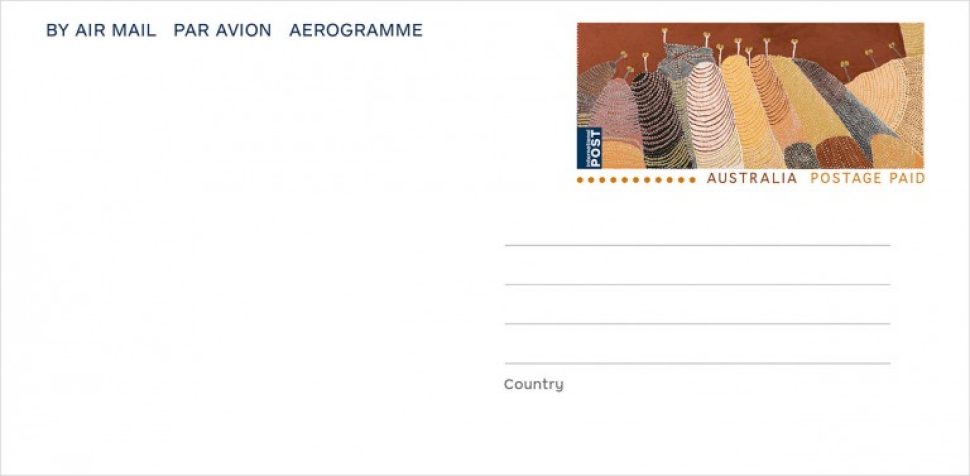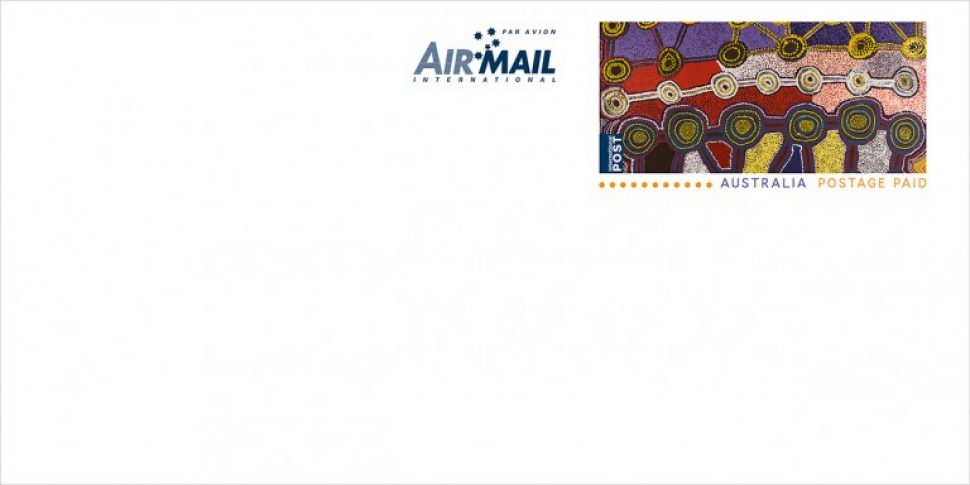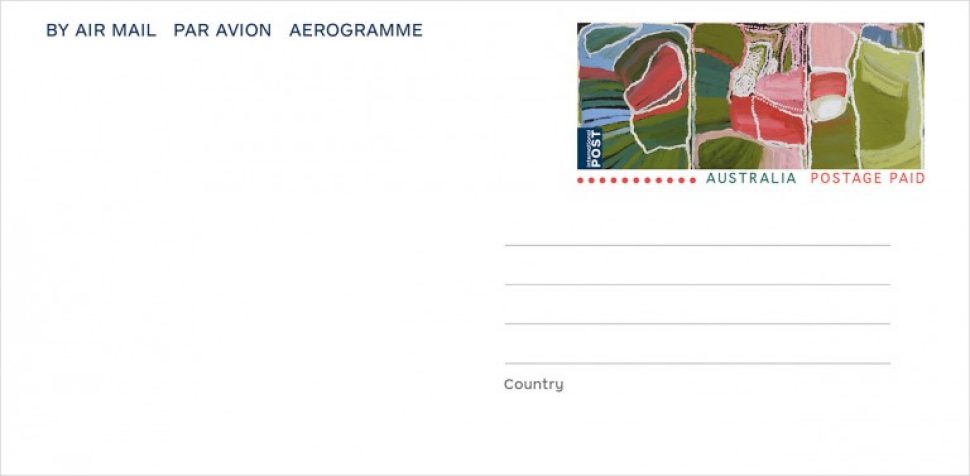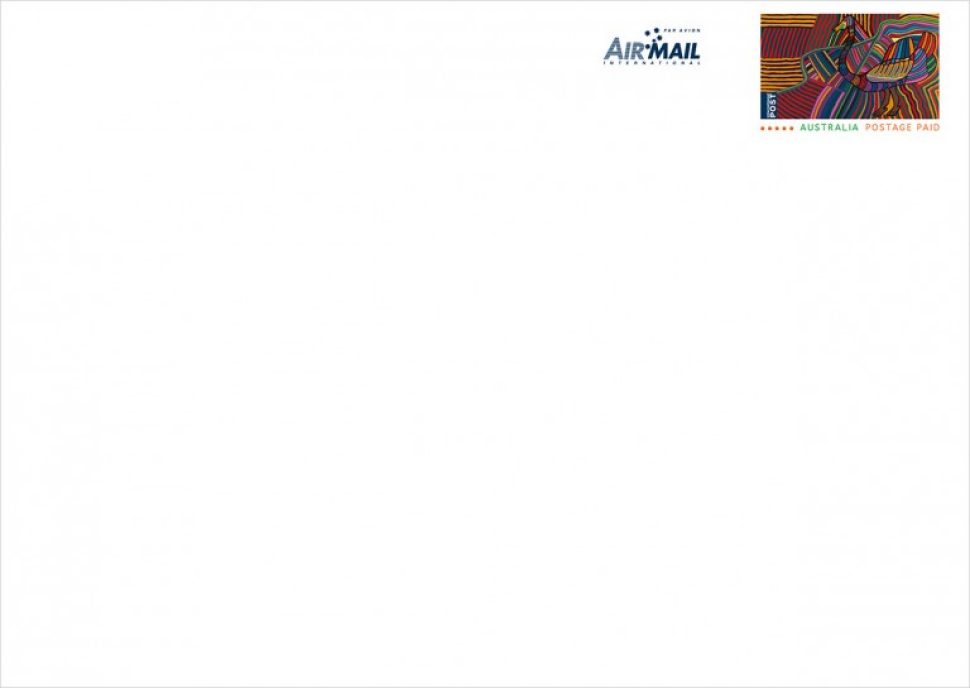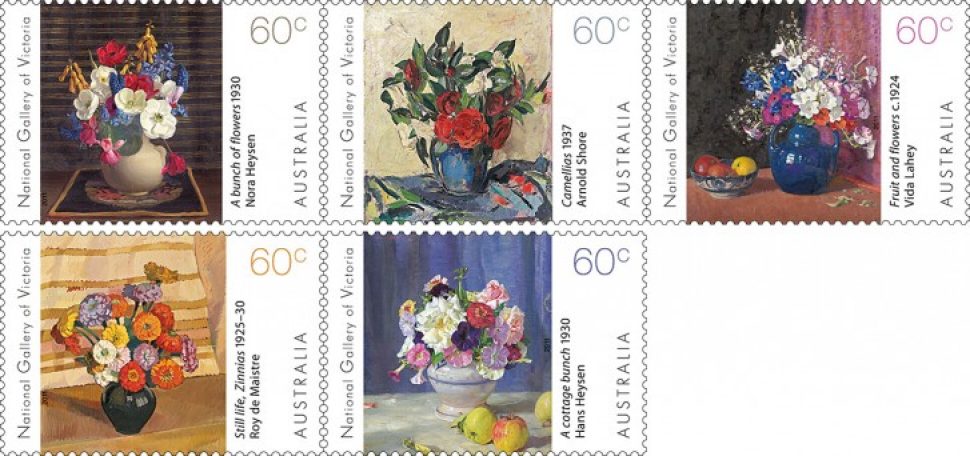The Art Gallery Aerogrammes and International Postage Prepaid Envelopes (IPPEs), released on 5 April 2016, is the third in a series of stamps and stationery based on works of art held in major Australian art galleries. The series showcases Australia’s rich artistic heritage through gallery collections. The artworks featured are by significant artists and provide us with insights into aspects of Australian culture.
This latest issue focuses on the Art Gallery of Western Australia, which was founded in 1895 and is located in the Perth Cultural Centre. The State Art Collection at the gallery comprises renowned collections of Western Australian, Australian and international art and design, as well as one of the finest collections of Aboriginal and Torres Strait Islander art in Australia. The gallery is strongly committed to showcasing Indigenous art, life and culture through the visual arts.
Art and artistic cultural expression has always been a very important part of Indigenous culture, demonstrating the deep connection between land, community and people. It is likewise an excellent form of political expression. Along with other mediums, art provides a way to communicate ideas, record events and pass Indigenous history and stories down through the generations.
The works featured in this latest issue in the series are from the State Art Collection at the Art Gallery of Western Australia. Curators from the gallery selected four significant Australian Indigenous art works to feature on aerogrammes and international postage paid envelopes, with striking results.
Patrick Mung Mung
Gawarre 2011 (detail)
Natural earth pigments, ochre and acrylic binder on cotton
150.0 x 180.0 cm
Purchased through the TomorrowFund, Art Gallery of Western Australia Foundation, 2012
State Art Collection, Art Gallery of Western Australia
© Patrick Mung Mung/Licensed by Viscopy
Patrick Mung Mung is a senior artist at Warmun Art Centre and an elder at Warmun Community in the East Kimberley. Like his late father, George Mung Mung (c.1921–1991), Patrick is a strong cross-cultural communicator.
In 1991, following his father’s death, it fell to Mung Mung to accompany his father’s carving Mary of Warmun to Canberra for the exhibition Aboriginal Art and Spirituality at the High Court of Australia. This occasion marked the beginning of a journey for Mung Mung, which was to see him take on his father’s role of senior artist, law and culture man.
Patrick Mung Mung was instrumental in establishing the artist-and-community-owned art centre at Warmun in 1998. Mung Mung has held many solo and group exhibitions, including several exhibitions in Germany.
Below is what Mung Mung has said about his Gawarre works:
“This is Ngarrgooroon Country, down near Halls Creek way. That’s the Gawarre, big mountain, high mountain, y’know? That’s where the old people bin’ living in the old days. The old people used to stop there, in those hills, like a home."
“Gawarre is the name of an outstation area in Purnululu National Park. The word also occurs as a general Gija word meaning ‘cliff’ or ‘range of steep hills’.”
Tommy Mitchell, Peter Lewis, Clifford Mitchell & Valerie Mitchell
Ngaturn Tingari [Wati] Tjukurrpa nd, not dated (detail)
Acrylic on canvas
213.4 x 152.8 cm
Transferred from Department of Commerce, Science, Innovation and Business, 2010
State Art Collection, Art Gallery of Western Australia
An important cultural maintenance project was undertaken in mid-2006 to mark the development of Warakurna Community’s new arts enterprise, Warakurna Artists.
The project involved a number of trips to sites of significance for Warakurna artists within the Ngaanyatjarra region. The family trips enhanced artists’ connection to country, provided an opportunity for intergenerational learning and enabled appropriate documentation of Tjukurrpa stories.
The cohesive series of paintings generated through the project have formed a valuable collection. The painting Ngaturn Tingari [Wati] Tjukurrpa tells a story about Ngaturn Tingari men travelling and meeting up with other Tingari mobs from Lapaku, Kintore and Docker River. All the Tingari men went together Kintore way to Lake MacKay for business.
Jan Billycan
Kirriwirri 2009
Synthetic polymer paint on plywood (3 boards)
92.2 x 182.8 cm (framed)
Purchased through the Leah Jane Cohen Bequest, Art Gallery of Western Australia Foundation, 2010
State Art Collection, Art Gallery of Western Australia
Jan Billycan (Djan Nanudie) (c.1930–2015) was an award-winning artist who grew up in Ilyarra country, near Punmu in the Great Sandy Desert in Western Australia. Bidyadanga, where Billycan painted, is a small place of approximately 800 people, 250 kilometres south of Broome.
The theme of “living water” or waterholes, known as jila, feature often in Jan Billycan’s work. There are many of them in Ilyarra country, including Karrparti, Kawarr, Jurntiwa and Wirrguja Jila as well as Dodo, Kartal and Kiriwirri (the subject of this painting).
Jan Billycan held many solo and group exhibitions, nationally and internationally, and her works are held within many public art collections.
Jimmy Pike
Pirnini country 1988
Multi-colour screen-print
67 x 85.1cm (sheet) 41.9 x 59.6cm (image)
Purchased 1988
State Art Collection, Art Gallery of Western Australia
Jimmy Pike (c. 1940–2002) grew up as a semi-nomadic hunter in the Great Sandy Desert. Following most of his relations, he left the desert as a boy and moved north to riverside country, where he was sent to work as a stockman on cattle stations.
He spent several years in prison during the 1980s, where he started to paint. He became one of Australia’s most famous Aboriginal artists during the 1990s through his series of paintings and limited edition prints, which depicted traditional stories and incidents from his early life.
In his later years, Pike travelled and exhibited in Australia and overseas, and his works have been shown in Tokyo, London, Berlin, Manila and Beijing, and toured in Italy and the USA.
In 1995 Jimmy Pike was honoured with a major Retrospective at AGWA. His last works were shown in London in 2014.
Previously in the Gallery Series…
National Gallery of Australia Landscapes 2013
Australian landscapes from the collection of the National Gallery of Australia, Canberra featured in a stamp issue released on 19 March 2013.
Selected from the NGA’s permanent collection, this issue of stamps features landscapes by five of Australia’s best known painters:
- Mr Robinson’s house on the Derwent, Van Diemen’s Land c. 1838 by John Glover
- Studley Park at sunrise 1861 by Nicholas Chevalier
- Dandenong Ranges from ‘Beleura’ 1870 by Eugene Von Guérard
- Land of the Golden Fleece 1926 by Arthur Streeton
- In the Flinders – Far North 1951 by Hans Heysen
These paintings convey a range of Australian terrain, from lush coast to the dry centre. The works were painted during the most prolific period of landscape art in Australia, from the late 1830s to the years following World War II. This was also a time when the Australian public began to visit their own galleries and museums to view and appreciate the beauty of their own landscapes.
National Gallery of Victoria Flowers, 2011
This stamp issue, released on 22 March 2011, features five flower paintings by Australian artists in the collection of the National Gallery of Victoria (NGV).
The NGV was founded on 24 May 1861 and is Australia’s first public art museum. It is recognised nationally and internationally for the breadth and significance of its collections, including the extensive collection of works by Indigenous and non-Indigenous Australian artists is housed in The Ian Potter Centre: NGV Australia at Federation Square, which opened in 2002.
Flowers have long been a favourite subject of artists, and this issue features a selection of superb floral still life paintings by Australian artists drawn from the collections of the NGV:
- A bunch of flowers 1930 by Nora Heysen
- Camellias 1937 by Arnold Shore
- Fruit and flowers c. 1924 by Vida Lahey
- Still Life, Zinnias 1925–30 by Roy de Maistre
- A cottage bunch 1930 by Hans Heysen
This article was produced at the time of publication and will not be updated.

